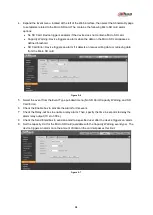
12
5 Network Configuration
Dahua IP cameras feature a built-in Web interface to control all aspects of camera operation. This
section includes details about the supported network protocols, configuring IP addresses, and
configuring alarms and local recording options. Refer to the camera’s
Operations Manual
for full
details.
5.1 Network Protocols
Dahua cameras support RTSP, RTP/TCP, RTP/UDP, HTTP, DHCP, TFTP, QoS, IP version 4 (IPv4)
and IP version 6 (IPv6).
RTSP
–
Cameras communicate with video management systems over Real Time Streaming Protocol.
Do not change the RTSP port unless you are sure your VMS does not use the default setting.
RTP/TCP
–
The Real-time Protocol/Transmission Control Protocol is best suited for applications that
require high reliability, and transmission time is relatively less critical.
RTP/UDP
–
The Real-time Protocol/User Datagram Protocol is used for live unicast video, especially
when it is important to always have an up-to-date video stream, even if some images are dropped.
HTTP
–
The Hypertext Transfer Protocol is an application protocol for distributed, collaborative,
hypermedia information systems.
DHCP
–
The Dynamic Host Configuration Protocol allows network administrators to centrally manage
and automate the assignment of IP addresses. DHCP should only be enabled if using dynamic IP
address notification, or if the DHCP can update a DNS server.
TFTP
–
The Trivial File Transfer Protocol is a simple, lock-step, File Transfer Protocol which allows a
client to get from or put a file onto a remote host. TFTP lacks security and most of the advanced
features offered by more robust file transfer protocols such as File Transfer Protocol.
QoS –
Quality of Service guarantees a certain level of a specified resource to selected traffic on a
network. A QoS-aware network prioritizes network traffic and provides a greater network reliability by
controlling the amount of bandwidth an application may use.
IPv4 –
The IPv4 (IP version 4) is enabled by default and obtains the IP address automatically. The
address can be used to allow or block network traffic that matches a specified address or protocol.
The IP address must be valid for the network. For more information, contact your network
administrator.
IPv6 –
A typical IPv6 (IP version 6) node address consists of a prefix and an interface identifier (total
128 bits). The prefix is the part of the address where the bits have fixed values or are the bits that
define a subnet. A typical IPv6 address may resemble the following example: 2001:db8: :52:1:1. The
IP address must be valid for the network. Before making changes to the IPv6 address, consult with
your network administrator.





































